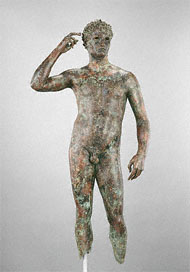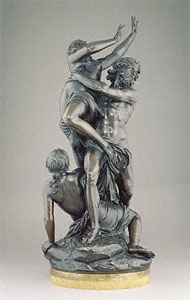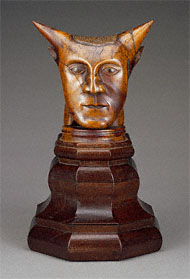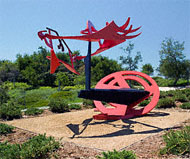Artist Adolph "Ad" Reinhardt (American, 1913–1967) once commented, "Sculpture is something you bump into when you back up to look at a painting." Despite Reinhardt's belief in the preeminence of painting relative to sculpture, three-dimensional works of art have withstood the test of time—literally and figuratively. Materials used to make sculpture, such as stone and bronze, make durable monuments that can withstand the outdoor elements. Moreover, materials like bronze are very costly; monuments made of bronze can establish a society or government's prosperity and power in the collective minds of generations to come.

|
||
Because sculpture frequently occupies space in much the same way as humans occupy space, we can identify with sculpture in a different way than with painting. Unlike painting, which traditionally represents an illusion of three-dimensional space on a flat surface, sculpture actually inhabits the space shared by the viewer. Sculpture is also tactile—one could actually touch it and feel its various textures and forms. Finally, looking at sculpture is a dynamic activity: the work changes as the viewer moves through space and time.
Early Forms of Sculpture
Sculpture has been used as a form of human expression since prehistoric times. The earliest known works of sculpture date from around 32,000 B.C. Early man created utilitarian objects that were decorated with sculptural forms. Ancient peoples also created small animal and human figures carved in bone, ivory, or stone for possible spiritual or religious purposes.
Traditions of carving and casting emerged from the ancient civilizations of the Mediterranean. The cultures of Egypt and Mesopotamia often created sculptures on a monumental scale. These sculptures related to religious life or functioned as a lasting memorial to the power of rulers. In ancient Greece and Rome, the human form was the dominant subject in sculpture, and the artists of classical Greece achieved a high degree of naturalism in sculpting the human form. From the rigid archaic male figures, known as kouroi, of the sixth century B.C. to the naturalism of Classical Greece and Rome, the human form was considered the most respected subject matter for art.
The Human Form and Its Sculptural Evolution
The depiction of the human form is evident throughout the history of Western art. The stiff and elongated figural forms of the Gothic style that were popular in the 12th through 14th centuries (see "Gothic Art" on the Metropolitan Museum of Art's Timeline of Art History) gave way, in the Renaissance, to the re-birth of ancient Greek and Roman naturalism and subject matter. Michelangelo borrows from the ancient world in his famous sculpture of David by carving the human form in a contrapposto pose—depicting an individual in a relaxed, natural stance on one weight-bearing leg.
Artists from the Baroque period that followed continued to depict the human form, often composing their works using multiple figures in very dynamic compositions. Human forms were depicted spiraling and twisting around an empty central vortex, or reaching out into the surrounding space. The movement and energy of these human forms gave viewers multiple viewing angles, such as that seen, below, in the sculpture Pluto Abducting Prosperine by Girardon.

|
||
Neoclassical Sculpture
In the 18th century, the discovery of and interest in ancient archaeological sites, such as Herculaneum and Pompeii, sparked a renewed interest in the arts of ancient Greece and Rome. Neoclassicism came from a desire to imbue the visual arts with greater seriousness and moral commitment—virtues thought to exemplify ancient ideals.
White marble, which evoked ancient sculpture, became the preferred material of the Neoclassical sculptor. In the 18th century there was a widely held, though erroneous, belief that people living in ancient times preferred this aesthetically pure material for their sculptural works. In fact, Classical marble sculpture was typically covered in brightly hued paint, which, due to weathering, had largely disappeared from the excavated works. Bronze was also often used in ancient times for large-scale sculpture. While a few examples of Classical bronze sculptures were known in the 18th century, the great majority of ancient works in this medium had been melted down for more practical applications after the fall of Rome. Most of the sculptures entering the great collections of Europe were marble; therefore, people living in the 18th century primarily associated marble with the ancient world.

|
||
Modern and Contemporary Sculpture
In the latter half of the 19th century and the early-20th century, a movement called Modernism departed from the Neoclassical style. At this time, sculptors showed less interest in naturalism and paid more attention to stylization, form, and contrasting qualities of the surface of the material, as seen here in Head with Horns, seen here. Artists paid greater attention to psychological realism than to physical realism. Later, artists' interest in the psychological resulted in more abstractedly stylized sculpture (as in the work of Henry Moore and Alberto Giacometti).

|
||
In the later 20th century, many artists continued to work in traditional media but began to explore abstraction or simplification of form and to eliminate realistic details. Some artists removed their sculptures from traditional pedestals and instead hung the work on wires or cables to allow movement and create kinetic sculptures. Other sculptors began to explore new materials, using found or discarded objects to create what is now called assemblage. In the mid century, some sculptors orchestrated the construction of their works using cranes to piece together large-scale sculptures in wood, stone, and metal. Other artists, valuing the idea or concept behind a work of art over the actual object, took a more hands-off approach in their work and created drawings and designs for art works, which were then fabricated by others.
More recently, artists have blurred the boundaries between different art media by mixing sculptural materials with sound, light, video projection, and two-dimensional images to create three-dimensional environments. This form of art, known as installation art, goes beyond the traditional viewing of a sculpture. Installation artists modify the way we interact with a particular space by creating an immersive, multi-sensory experience in which a viewer can participate.